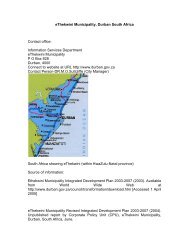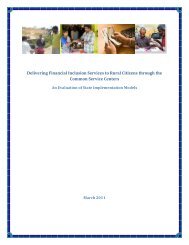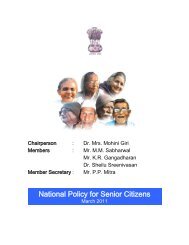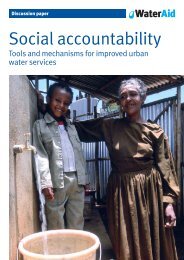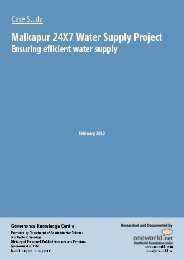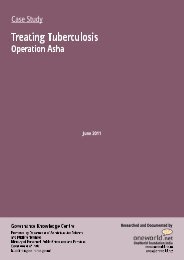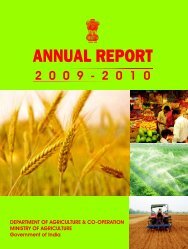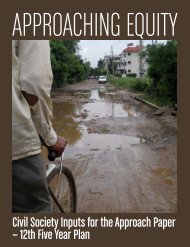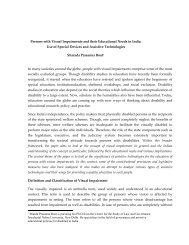Changing Framework of Local Governance and - Create
Changing Framework of Local Governance and - Create
Changing Framework of Local Governance and - Create
You also want an ePaper? Increase the reach of your titles
YUMPU automatically turns print PDFs into web optimized ePapers that Google loves.
<strong>Changing</strong> <strong>Framework</strong> <strong>of</strong> <strong>Local</strong> <strong>Governance</strong> <strong>and</strong> Community Participation in Elementary Educationaffairs. One such effort may be to improve trust with the community by involving them indifferent activities including financial transactions. One Government <strong>of</strong> India document states:To ensure effective participation, it is essential to have faith in the community abilitywithout which all efforts to bring about their participation would be half hearted. Thecommunity is heterogeneous, stratified <strong>and</strong> has different sections with differing <strong>and</strong>sometimes antagonistic interest too. While eliciting community support, it is importantthat persons belonging to deprived sections get due representation in the form createdfor community participation (GoI, 1999:13).In view <strong>of</strong> this, more <strong>and</strong> more community-based activities have found their place in SSAplans. In some states, local self-government bodies have been given the authority to select <strong>and</strong>recruit teachers. For example, the Rajasthan Government has modified the procedure <strong>of</strong>teacher recruitment such that while regular primary school teachers are recruited by ZillaParishads, (Ramach<strong>and</strong>ran, 2001). Gram sabha <strong>and</strong> panchayats are entrusted with theselection <strong>of</strong> para-teachers. It may be mentioned that even though some aspects <strong>of</strong> thisapproach to teacher recruitment has been questioned, empowering local self governmentbodies with respect to the governance <strong>of</strong> elementary education has been one <strong>of</strong> therecommendations <strong>of</strong> constitutional amendments concerning the composition <strong>of</strong> PanchayatiRaj bodies. Almost all states have taken this policy option to meet the challenges <strong>of</strong> increasingenrolment by recruiting more <strong>and</strong> more teachers at the local level.In spite <strong>of</strong> policy recommendations, the examples <strong>of</strong> the non-participation <strong>and</strong> exclusion <strong>of</strong>parents <strong>and</strong> community from school affairs is still apparent in many cases <strong>and</strong> this is a majorconcern. Often their participation remains limited to the contribution <strong>of</strong> resources in cash orkind 31 . <strong>Local</strong> management <strong>of</strong> education, community participation in educational management,building community ownership, seems oversimplified. One recent study (Ramach<strong>and</strong>ran,2004) has explored the complex web <strong>of</strong> interrelationships between social power <strong>and</strong> formaleducation. In a review <strong>of</strong> this work, (Manjrekar, 2005:248) states that:Dynamics <strong>of</strong> poor at the family, community <strong>and</strong> village level determine which childgoes to which school, which groups have a say in the working <strong>of</strong> local levelcommunities to monitor education, as well as the social experience <strong>of</strong> the child inschool. The types <strong>of</strong> schools available <strong>and</strong> their location within villages marked bycaste separation <strong>and</strong> segregation also play a critical role in influencing parent’sdecisions about schooling for their children. What emerges clearly is that in a situationwhere parallel systems <strong>of</strong> schooling exist, who goes to which school is increasinglycoming to be defined by the child’s gender, class caste <strong>and</strong> community…….. similarcomplexities arise in the context <strong>of</strong> village education committees, where local politics<strong>of</strong> class caste <strong>and</strong> gender play an important role in their working.Problems regarding community participation are also found in states like Kerala. A recentstudy by Mukundan <strong>and</strong> Bray (2004) indicates that the rhetoric <strong>of</strong> decentralisation in theeducation sector does not match the reality in this state that has strong reputation for politicalparticipation <strong>and</strong> has introduced recent initiatives for decentralisation. Experience shows thatmany institutional structures such as Village Education Committees <strong>and</strong> school complexes31 The study conducted by Ramach<strong>and</strong>ran et.al. (2002:1608) reveals that the “evidence from the field indicatesthat they (VECs) either do not function or seem to function with a mechanical intensity rather than a genuinesense <strong>of</strong> participation <strong>and</strong> commitment.” While in Haryana, the VECs were found upholding “the interests <strong>of</strong>dominant group”, (1608) in Madhya Pradesh, “caste identities were reflected in school committees” (1608).28




